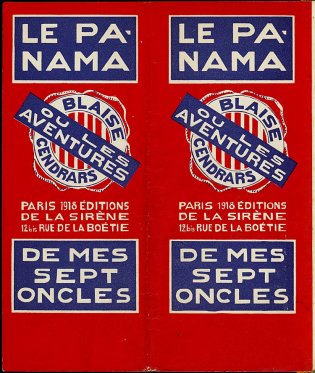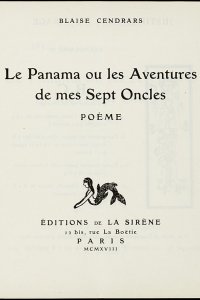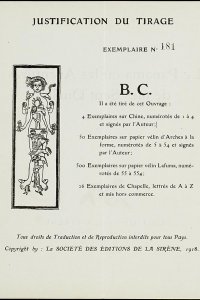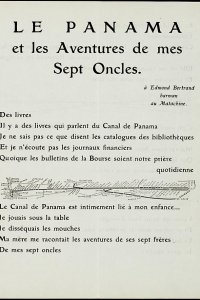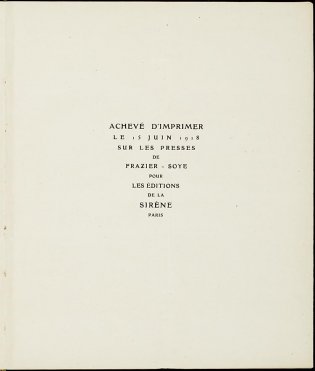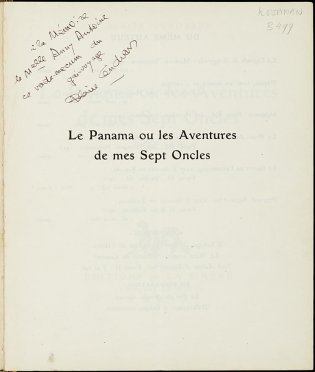Le Panama ou Les aventures de mes sept oncles : poème
Year: 1918
Author: Blaise Cendrars (1887 - 1961)
Publisher: Éditions de la Sirène
Cover
Blaise Cendrars was born near Neuchâtel in 1887 and died in Paris in 1961. This life would seem to be clear-cut, but it was hardly that simple. Cendrars started out as a world traveller, which was later described in his books. Not only did he leave hearth and home in 1904 to become an apprentice jeweller in Saint Petersburg, but he exchanged his actual name (Fréderic Louis Sauser) for the pseudonym under which he became famous.
In 1907 he departed to Switzerland (Bern), in 1910 he travelled on to Paris, only to leavefor New York in 1911 via Saint Petersburg. Here he wrote his first work, Les Paques, under the pseudonym Blaise Cendrart. That last't' would ultimately make way for an 's'. It was a carefully chosen pseudonym: the Christian name Blaise stood for the fire (braise) that changes everything it touches into ashes (cendres): 'writing is being burned alive, but it also means being reborn from the ashes'. That burning also had to do with a childhood friend from Saint Petersburg, who was burned alive in 1907 (probably suicide).
Dynamic poetry
After his return to Paris, Cendrars devoted himself to the world of small publishers, artists and anarchists. Together with Sonia Delaunay, he published the now highly valuable book La prose du Transsibérien et de la Petite Jehanne de France. This edition was published in 1913 by Éditions des Hommes nouveaux with pochoir illustrations by Delaunay on four elongated sheets of paper. The illustration is on the left, and the text is on the right, with colour panels printed through the text. At the very top, next to the title information, a map of Siberia is visible. Cendrars used parts of a map for another poem too: Le Panama ou les aventures de mes sept oncles. This tenth publication of La Sirène contains a woodcut in Inca style, a facsimile of a brochure about Denver, and 25 figures of railroad tracks.
-
Title page
-
Edition statement
-
Le Panama ou Les aventures de mes sept oncles : poème, page 7
Colophon
Trains to West and East
The poem Panama or the adventures of my seven uncles is a panorama of its time, starting with the Panama scandal, which ruined several financiers and investors. The parents of the poem's narrator are among the victims, and are forced to move into a smaller home. The mother then tells the young narrator about her brothers, his seven uncles. Their life stories typify the first 15 years of the twentieth century, through the use of slogans and names: 'Strindberg has demonstrated that the world is not round', 'The pumas that nest in the dented gas tank', 'I am homesick I am every face and I am afraid of letterboxes', 'Toyo Kisen Kaisha'. All this is defined by the authorwith the following words: 'It is the poetry of today'.
The book's design is defined by two elements: the long lines of verse that must often be broken off, and the railroad's route tickets. The trains run from West to East in America, from Chicago in the North or to St Louis in the South, or from Chicago to Ashland. They don't actually have much to do with the poem, but they do give an impression of the poem's speed. They are indications of what the narrator can remember and what he chooses to divulge about facts and current affairs. We therefore find lines of poetry that let us know that the Los Angeles Limited departs at 10.02, arrives three days later, and is the only train in the world with a barbershop on board.
Half-title with dedication from Blaise Cendrars to Louis Koopman
In the middle of all the pages there is a vertical folding line; the booklet is supposed to be folded in half.It resembles a travel guide with its cover printed in red and blue, stickers that look like they've been stuck on the outside, and a lifesaver with the author's name printed on it. The copy owned by the National Library of the Netherlands is one of the 500 copies printed on Lafuma paper (number 181), but it does include a dedication in the author's handwriting commemorating Anny Antoine: 'à la mémoire de Mlle Anny Antoine ce vade-mecum du gai-voyage. Blaise Cendrars'.
Bibliographical description
Description: Le Panama ou Les aventures de mes sept oncles : poème / Blaise Cendrars. - Paris : Éditions de la Sirène, 1918. - [42] p. : ill. ; 24 cm
Printer: Frazier-Soye
Edition: 580 copies
This copy: Number 181 of 500 on Lafuma
Note: With an autograph dedication from the author to Louis Koopman
Bibliography: In liefde verzameld-250 ; Mahé I-441
Shelfmark: KW Koopm B 499
References
- Paul van Capelleveen, Sophie Ham, Jordy Joubij, Voices and visions. The Koopman Collection and the Art of the French Book. The Hague, Koninklijke Bibliotheek, National Library of the Netherlands; Zwolle, Waanders, 2009
- Paul van Capelleveen, Sophie Ham, Jordy Joubij, Voix et visions. La Collection Koopman et l'Art du Livre français. La Haye, Koninklijke Bibliotheek, Bibliothèque nationale des Pays-Bas; Zwolle, Waanders, 2009
- Blaise Cendrars, Panama of De avonturen van mijn zeven ooms. Utrecht, IJzer, 1999
- Miriam Cendrars, Blaise Cendrars, l'or d'un poète. Paris, Gallimard, 1996
- Claude Leroy présente L'or de Blaise Cendrars. Paris, Gallimard, 1991
- Pascal Fouché, La Sirène. Paris, Bibliothèque de Littérature française contemporaine de l'Université Paris, 1984
